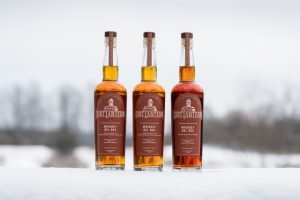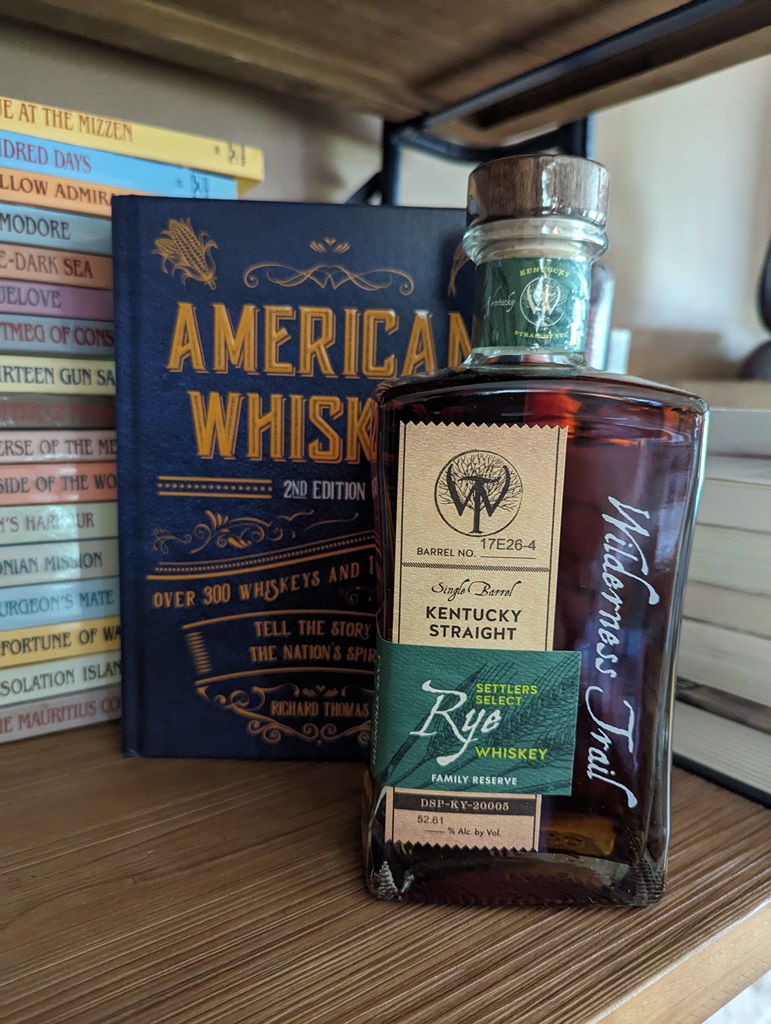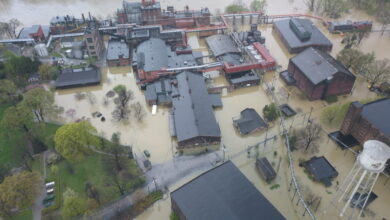Q&A With Lost Lantern Whiskey
By Kurt Maitland

(Credit: Lost Lantern)
American whiskey has changed. Bourbon and rye are still dominant, but craft is a vibrant thing, and it feels like American Single Malt has seen more and more attention on the domestic scene. But lots of distilleries fly under the radar and are only known to an observant few. Thankfully we have Lost Lantern doing their damnedest to show the depth and breadth of American whiskies.
The first sentences of Lost Lantern’s mission statement are as follows:
Shining a light on the independent spirit is our tagline. It’s also our mission. That means we spend the time to truly explore and understand the landscape of American whiskey. We find unique and exciting whiskies from every corner of the United States.
Sounds good to me!I had the pleasure of speaking to Nora Ganley-Roper and Adam Polonski, the co-founders of Lost Lantern about their brand and the road ahead.
KM: First off, tell our readers a bit about yourselves and how you started your company.
LL: Both of us come from the whiskey industry, but in different ways.
I [Adam] worked as a journalist before Nora and I started Lost Lantern. Originally, I covered video games for Newsweek. Then I switched over to writing about cocktails and the on- and off-premise spirits business for Market Watch. There, I learned a ton about whiskey and eventually had the opportunity to start writing and reviewing for Whisky Advocate.
Nora studied physics and dance at Barnard/Columbia and then worked for several years in finance. She had always had an interest in wine, and eventually started reading long wine textbooks about Bordeaux, Burgundy, Barolo and much more while commuting to Connecticut on the company bus every day. It gave her a lot of time to build her expertise! She then left finance to work at Astor Wines & Spirits, and quickly became the sales manager. That meant that she had to know just as much about spirits as about wine, and she quickly built up her knowledge base until whiskey became just as much of a passion as wine had always been.

(Credit: Lost Lantern)
By then, she knew she eventually wanted to start her own business, so she worked in startups for a few years building her operational expertise. So, she had the perfect background to be able to build and run our business.
KM: How difficult was it to get the first brands on board? What questions did they have for you?
LL: Early on, we knew we’d have the best luck talking to American single malt brands–since they tended to be quite familiar with the Scotch world and Scotch independent bottlers. In fact, some distilleries even told us they had been waiting for someone to do something like this, and they were quite eager to get on board… at least once they saw that we knew what we were talking about and had a real plan.
It really helped that we spent 8 months traveling the country and visiting distilleries to pitch our vision, and to understand how they were doing things. That showed them that we were really committed to this and helped us make or deepen personal connections.
Bourbon and rye distilleries usually needed more of an explanation, since “sourcing” had become something of a dirty word in the early days of craft whiskey. But they saw that we were going about it in a very different way, that we wanted to help tell their stories and support their brands.
We always wanted to work with distilleries that were excited about the idea of an American independent bottler… places that wanted to work with us because they wanted something like this to exist. Luckily, there were a number of places like that even early on, and now we’ve established ourselves enough that the conversations have gotten a lot easier and require less explanation of what we’re doing.
KM: What do you look for when selecting a brand to work with?
LL: Above all, we want to work with distilleries that have a unique perspective, that truly have something to add to the conversation. If you’re making great whiskey that reflects a unique climate, or innovates on traditional production methods, or pushes the boundaries of flavor, we want to talk to you. If you’re making whiskey that tastes great but just does exactly the same thing as other distilleries have already done, but you just happen to be located somewhere else… that’s not nearly as interesting to us. Great whiskey should reflect where and how it’s made, and that’s what we seek out.
KM: Are there specific flavor profiles you are looking for? Does the fact that you are also crafting blends affect those choices?
LL: We are not usually looking for very specific flavor profiles; we don’t want to put ourselves into a box like that. Instead, we want to find the very best of what’s out there, rather than hunting down whiskies that meet specific criteria. We never knew we wanted to have a rye whiskey finished in an ex-sloe gin cask, until we discovered that Spirit Works Distillery made one. We would never even have thought to ask!
For blends, we’re sometimes more particular or hunting down specific flavor profiles; but that will usually be from distilleries that we’ve worked with before, and we can go to them and ask for something specific.
KM: As you are not forced to make the same blends over and over again, can you talk our readers through how you make your blending choices?
LL: Sometimes we source whiskey explicitly for blending specific projects. That was the case with the whiskey we sourced for SHADOW and FLAME, the peated blended malt and mesquite-smoked blended malt we’re releasing in late November. We knew we wanted to showcase the world of American smoked whiskey and bought whiskey explicitly for that purpose.
Other times, ideas for blends start to emerge as we taste through what we have in our cask library. This was the case for Far-Flung Bourbon: we had been toying with and working on various types of bourbon blends for a while, looking at blending whiskies that all had the same mashbills, or were from the same region of the country, etc.… but ultimately, we decided that our favorite flavor profile didn’t really have a specific theme. It was just a blend of great bourbons from great distilleries in four very far-flung places! Hence Far-Flung Bourbon.

Credit: Lost Lantern)
KM: What do you find is the hardest part of the blending process?
LL: [Adam] To me, the hardest part is knowing when you’re done, knowing when you should stop tinkering around the edges and lock the final blend. It’s easy to play around forever, if you have the luxury of time–to constantly tweak proportions or add or remove barrels. You can make yourself crazy. At the same time, you don’t want to finalize something if another few days of fiddling could make it 20% better! It’s a really tough balance to tread.
KM: Talk to us about your tasting rooms/labs? How do these compare to what you had access to at your prior jobs?
LL: Lost Lantern now has its own production space and tasting room, after several years of contract bottling! Our blending lab is still fairly informal as we get settled in the new space, but it’s great to have easy access to all the samples and barrels whenever necessary. Over time, we’ll build a more official blending library and likely revisit many past samples as we explore new blends.
Whisky Advocate had a vast library of whiskey, as you would expect, but it was all in bottles, not barrels! So it was a very different proposition. It was a fantastic place to learn about whiskey and develop a very experienced palate, but blending is something we’ve learned more about from the various distillery partners we work with.

(Credit: Lost Lantern)
KM: How did your prior jobs impact what you do with Lost Lantern?
LL: [Adam] For me, I learned to taste at Whisky Advocate and bring their ethos and commitment to blind tasting to Lost Lantern as well. It also helped me build some of the relationships with distilleries that we work with to this day.
[Nora] My experience at Astor Wines & Spirits really helps with the customer perspective. What people are looking for, how they ask questions, and how we can best serve interested whiskey drinkers. On the other end of the spectrum, my experience working for startups in NYC helped teach me how I want to build our business. A lot of what we’re doing in the business structure and how we hire and manage people, comes from the things that I saw that I both liked and didn’t like in previous jobs.
KM: With access to Scottish single malt tight at the moment, I’m sure it doesn’t surprise you that other Independent bottlers are talking about delving into American Single Malt. Will the possible entry of new players change or affect what you do?
LL: We’re glad that Scotch independent bottlers are starting to look at American single malt! We think that will help bring much greater international awareness of this style of whiskey. We also think there will be more homegrown independent bottlers over time, too. There are hundreds in Scotland, after all… and there are far more whiskey distilleries in the United States now than there ever have been over there (granted, most here are still very small!).
We welcome more independent bottlers starting to work here. We think it will help broaden awareness of the model and what it has to offer. And we’re not worried about issues with supply here anytime soon–we have good established relationships with a number of distilleries and there are also more distilleries maturing all the time.
KM: Do you have any interest in bottling single malts from countries other than the US? If so can you give us some hints?
LL: We do have interest in bottling world whiskies–single malt or otherwise–with two important caveats. First off, we still feel like we need to establish ourselves in the U.S. a little more! Second, and more importantly, we want to work with international distilleries in the same way that we work with U.S. distilleries. That means we need to visit in person and understand how they do things, how their climate and unique perspective affects what they do, etc.
And much as we’d love to spend a bunch of time globetrotting and visiting whiskey distilleries in Scandinavia, Australia, Taiwan, England, Mexico, and beyond… we just don’t have the time or a large enough team to be able to do it yet! Someday!
KM: When you get a chance to do your own finishes, are there barrels you are looking forward to working with?
LL: Yes! We are very interested in exploring finishes that are arising naturally out of American traditions. We love classic Old World finishes like Sherry and Madeira, but we personally love that distilleries are starting to develop new traditions that are rooted in our history.
Specifically, we can’t wait to explore finishing in apple brandy casks, potentially maple syrup casks (although it needs to be a light touch!), and in various Vermont beer casks. We also occasionally have interesting empty casks from our own partners after we bottle something and look forward to using some of those in finishes as well.
KM: If you had a crystal ball, where would you like Lost Lantern to be in 5 years’ time?
LL: We want to be well on our way to being the premiere American independent bottler! We hope we will continue to grow our reputation for blending and sourcing unique and interesting whiskies and help introduce people to lots of whiskies and distilleries they’ve never encountered before. I hope by then our releases will be substantially larger and we’ll have one or two recurring flagship releases (potentially Far-Flung Bourbon), but we’ll see! And in 5 years, we will probably be starting to export our whiskey more regularly and beginning to look at international sourcing.


